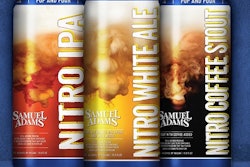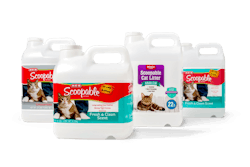One of the largest car care brands in the world, Chicago-based Turtle Wax is committed to formulating innovative product lines to meet the ever-changing needs of car consumers and the automotive industry. The 70-year-old, family-owned company distributes car wax, car detailing, and car care products in more than 90 countries around the world and ranks high with consumers in the areas of quality, trust, and familiarity. Just this year, following a survey of more than 40,000 consumers, its Quick & Easy Dash & Glass Interior Cleaner was named Product of the Year for 2016.
However, over the years, as Turtle Wax launched new products, the packaging for its lines became inconsistent. Different SKUs, even within a single category like spray products, utilized different packaging structures, varying shades of the company’s signature green, and disparate label shapes and branding schemes. While there was a family resemblance, there was no standardization.
In addition, for those products that had been on the market for decades, the package aesthetics had become antiquated, resulting in negative consumer connotations of “old school” and “dated.”
In late 2012, Turtle Wax began a rebranding project to refresh, customize, and standardize the packaging across its multiple product categories in the U.S. The first packaging format to undergo the transformation was its trigger spray bottles, which were redesigned with a youthful, energetic new structure and contemporary label graphics that brought the shine back to the brand.
Turtle Wax moves into the Vortex
As Laurie King, VP Global Supply Chain & Operations for Turtle Wax, explains, the trigger bottle format was ripe for change. “We were using standard trigger bottles for probably the last 20 years,” she says. “We tended to make changes on our labels and our graphics more so than with the rigid structures, depending on the marketing plan or strategy for the individual product.”
In making the change, Turtle Wax was looking for an ownable, custom structure, as studies had shown that consumers perceive generic bottles as cheap. “First and foremost, from an aesthetic standpoint, we wanted an updated, fresh look,” King says. “Because we are an automotive care products company, we were also looking for a design that showed motion and speed, with the labels tying into that.”
In terms of functionality, King says the bottle needed to have greater ergonomics, with a shape that was easier for consumers to grip.
To find the best solution, Turtle Wax solicited custom design proposals for its 16-, 23-, and 26-oz PET bottles for 10 SKUs of its Jet Black, Quick & Easy, and Performance Plus lines. After evaluating proposals from multiple suppliers, the company selected a concept from Berlin Packaging’s Studio One Eleven: the “vortex” bottle.
Described by Ann Fisher, Senior Account Executive for Berlin, as having a “forward twisting motion,” the vortex bottle has a unique neck and base design that features deeply angled, whirlpool-like grooves that run from the top to the bottom of the bottle. The dynamic movement of the package structure was then complemented by label graphics suggesting speed.
From a package manufacturing and filling standpoint, both King and Fisher say some tweaks in the design were required, but the transition was a smooth one. Alpha Packaging supplies the PET bottles, which incorporate 30% post-consumer material.
Another aspect of the redesign was to standardize the color of the bottle across product lines. For its Performance Plus and Quick & Easy lines, Turtle Wax uses its signature green, and for the Jet Black line, a black bottle. The bottles, respectively, are fitted with custom green and standard black Mixor trigger sprayers from WestRock.
Preform provides environmental benefits
For any CPG, using less packaging material is always a plus from both an economic and an environmental perspective. Says King, “We always look to right-size the gram weight of our packaging. Before the redesign, there had been talk about going to a different gram weight, but the idea didn’t necessarily get legs until we went into this relaunch and were able to standardize.”
Using lighter-weight preform technology from Alpha, Turtle Wax significantly reduced its resin use by 62,000 lb per year. The 16-oz bottle, reduced in weight from 43 to 34 g, uses 21% less plastic, and the 26-oz size, which went from 53 to 43 g, uses 19% less.
Says Fisher, “Alpha came out with lighter-weight preforms right as we were designing the new bottle, so we were able to fit our designs into those lower-weight preforms without sacrificing bottle quality.”
Turtle Wax also scores sustainability points for its continued use of 30% PCR PET in its bottles—exceeding California’s 25% PCR requirements for bottles in this size range—which saves the company more than 116,000 lb of virgin plastics per year, based on the its historical sales volumes. “We have always used PCR content, but we’ve gone to a higher percentage over the past few years,” says King. “The majority of our bottles are PET, which is very helpful.
“We’re very conscious of sustainability. Our major customers ask us to report on that, and we are required to meet California’s mandates. We always try to take the right approach.”
Label matched to consumer expectations
An inside job, with assistance from brand and design strategist Kaleidoscope, the redesign of the labels and label graphics for the Vortex bottle was informed by consumer research, explains Turtle Wax Brand Manager Jake Viner. “We used consumer studies to filter through multiple design iterations, to evaluate the competition, and to determine optimal design features,” he explains. “This was achieved through qualitative focus groups and quantitative surveys, which used more advanced tools such as heat maps and measuring the time it took consumers to find our product on shelf.”
The goal was to replace outdated label graphics with more a more youthful design, while at the same time maintaining the historic brand language of Turtle Wax. As Viner explains, core equities such as the Turtle Wax logo and the color green were retained, “however the logo was updated with a more contemporary style that could translate across all of the product lines.”
Designed to complement the shape of the Vortex bottle, the swoosh-shaped front-panel label covers the entirety of the body, providing a spacious billboard for images and copy. On the bottom of the label, custom car photography “captures the right angle, shine, and style to fit the target audience,” says Viner. “Our consumers are visual and detail-oriented. They want their cars looking immaculate. So our labels had to fit that consumer expectation.”
The new design uses fonts that are contemporary and easy to read, and color bands with copy that distinguish the product line—blue for Performance Plus, yellow for Quick & Easy, and red for a new line that was transitioned into the Vortex bottle, Renew Rx. The nozzle of the trigger spray is likewise color-coded. Metallic silver inks add a premium appearance and shine to the labels.
As Viner relays, having a consistent, standardized label architecture and visual identity across the brand has not only made it much easier for consumers to shop for Turtle Wax products within the car care category, but it has also simplified navigation across Turtle Wax product lines. “We can also now merchandise a wider breadth of the portfolio in a unified end cap or in our advertising campaigns,” he adds. “Lastly, it provides structure for future products by removing the need to reinvent our design every time we launch a new product.”
Staggered transition
The first new trigger spray bottles were launched in 2013, with full penetration of the redesigned packaging nationwide in 2014. In 2015, Turtle Wax introduced its ICE car protection and shine product line in the Vortex bottle, in a blue color. In total, nearly 35 SKUs have been moved to the Vortex bottle, and Alpha is currently building molds for 12-, 20-, and 64-oz bottles for use with additional SKUs.
After the U.S. redesign, Europe followed suit, working with Redshoe Brand Design to tweak the design for its products, some of which are different from those sold in the U.S. Says King, “The European market had to do a fair amount of work to actually get into those trigger spray bottles for the ‘green line’ of products. Their line was much more fragmented initially.”
In the U.S., retailers—Turtle Wax products are sold in the auto trade and mass retail markets—responded positively to the new design. “The auto appearance category is a difficult one to shop,” explains King. “Anything you can do to streamline it is welcomed by retailers.
“In addition, we continue to get consumer feedback about the look and feel of the new bottle. It’s easier to shop, and it’s easier for consumers to find products and understand what they are used for, so we get positive feedback about that as well as the aesthetics overall.”



























